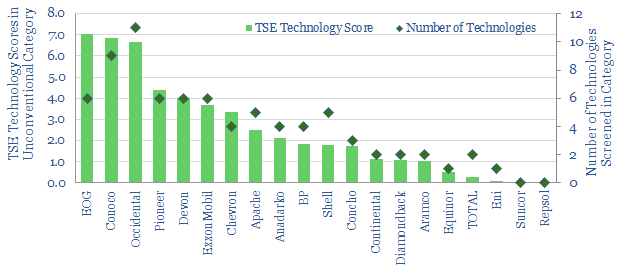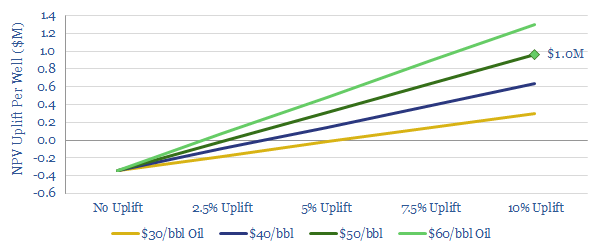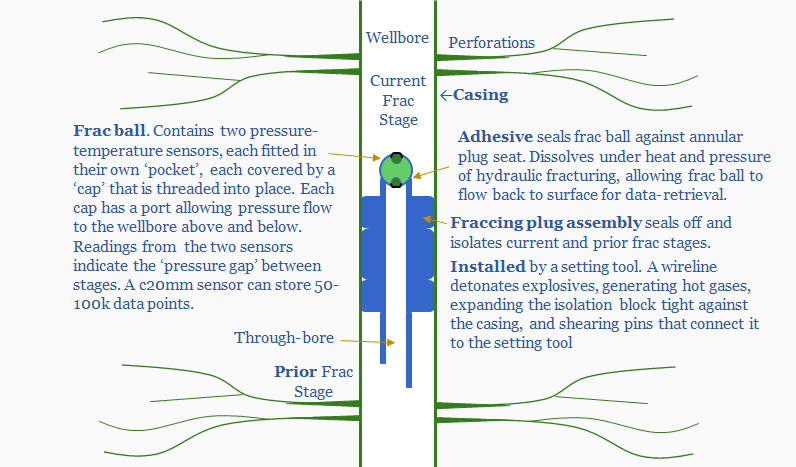EOG has patented a system to deploy pressure and temperature sensors in its frac plugs, which are then retrieved at the surface, providing low cost data on each frac stage. The data can be used to improve subsequent frac stages. We model the economic uplifts at +$1M NPV and +5% IRR per well (at $50 oil).
[restrict]
EOG screens among the leaders in shale technology, based on the patents and technical papers we have reviewed so far. However, the company is secretive over its intellectual property, notoriously banning camera-phones from its well-sites and publishing fewer technical papers relative to its peers.

However, last year EOG filed a patent for one of its data-methodologies, which we believe is being applied in its operations in Texas.
Specifically, EOG is housing “sensor pods” in its frac plugs. Each of these pods can record 50-100k data points, logging temperature and pressure during a frac stage. Later, the frac plugs are released, and retrieved back at the surface, where their data can be downloaded.
This methodology allows EOG to measure actual frac pressures down-hole, close to the perforations, for each, individual frac stage. The readings are likely to be much more accurate than the inferences from the surface. Downhole temperatures can also be measured.
Why is this useful?
First, the data can be used to enhance EOG’s modelling of the fracture network. In turn, this can be used to infer mechanical properties of the formation, and optimise future frac stages: tailoring perforation geometry, injection rates, sand concentrations, fluid viscosity and chemicals compositions.
Moreover, the data can be used to detect problems. If a frac stage has not been properly isolated, then pressure will not build up as much on either side of the frac plug. If a well is unexpectedly flowing(/not flowing), then downhole fluids will be warmer (/cooler). In another design, the sensors can be placed in neighbouring wells to detect frac hits.
If all of these factors can increase well productivity by c10%, then we estimate the NPV uplift at $1M NPV or +5% IRR per well. The technology breaks even if it can uplift EURs by c2.5%. These numbers vary based on the oil price (chart below, model here).

Wouldn’t fibre be better?
We have seen other operators making enormous strides deploying down-hole fibre-optics, to monitor pressure and temperature, meter-by-meter, in real-time across a 20,000ft well. This would offer more granular data, immediately. I.e., you would not need to wait until the sensor pods are retrieved at the surface to download their data.
However, we do not believe the cutting edge of fibre is currently practical for common usage in the shale patch: running the complete works of fiber-optics across an offshore well can surpass $1M. As we have learned from other patent-filings, retrievable plugs can be run “at a fraction of the cost associated with a tethered downhole sensor”. Our numbers above assumed $0.4M incremental costs for deploying EOG’s sensors across a 40-stage stimulation.
Another leading example of big-data
As we have highlighted in ‘Winner Takes All‘, shale is increasingly a ‘tech’ industry, harnessing advanced modelling or data-based optimisation in 60% of the 300 technical papers we reviewed from 2018 (chart below). So here is a cutting edge example from EOG.

References
Bustos, O, Raizada, S., James, C. et al (2018). Completion and Productions Apparatus and Methods Employing Pressure and/or Temperature Tracers. US Patent No 2018/0252091 A1
Naldrett, G., Cerrahoglu, C. and Vahue, M. (2018). Production Monitoring Using Next Generation Distributed Sensing Systems. Petrophysics. Volume 59.
Deffenbaugh, M., Ham, G. D., & Alvarez, J., O., et al (2016). Method And Device For Obtaining Measurements Of Downhole Properties In A Subterranean Well. Saudi Aramco Patent US2016320769
[/restrict]
